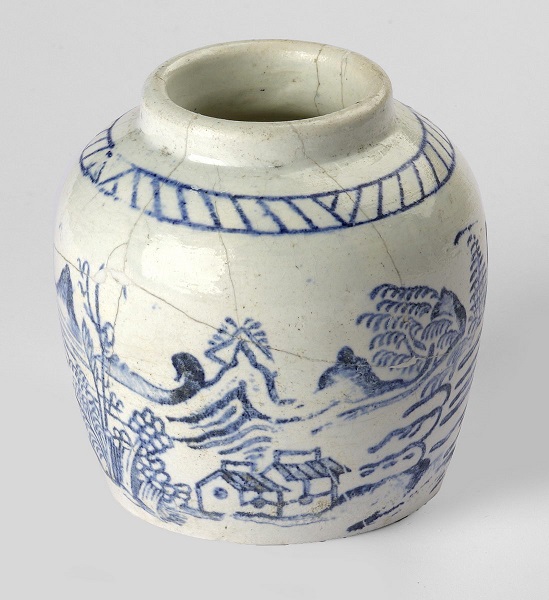Provenance: unknown
Workshop: unknown
Terracotta: turning on a wheel, drying, glazing, painting on raw glaze, probably with cobalt compounds, firing
Dimensions: height approx. 5.6 cm, dia. basic 6 cm
Inw. pre-war: HMM WPr. 395
On August 11, 1925, the Regional Museum in Kwidzyn received a gift from Mr. Kuczkowski, a resident of Dzierzgoń (German: Christburg), a small – as the record shows – a terracotta container worth only 1 mark. Waldemar Heym added: chinesisch? In the inventory, so at that time he had doubts whether it was a Chinese vessel (fig. 1). Three years later, the Kwidzyn Museum received a similar but stoneware ginger container (pre-war inv. HMM WPr. 1477), decorated with a painted Chinese-style lake landscape (West Lake theme) as a gift from a deceased resident of Kwidzyn, a certain Mielke. Here, too, Heym had doubts. He alleged a forgery because the object was quite heavy and bulky. Fortunately, this container has survived and is now in the collection of the Kwidzyn Castle under inv. No. MK / S / 327 (Fig. 2).
The lost item is a small, squat, barrel-shaped container, on a low cylindrical base, with a wide, rounded shoulder and a low, wide neck. The painted decoration on the frieze probably depicted a dancing dragon or a flower branch, painted underglaze with blue dye.
Bible: Inventar Heimat Museum Marienwerder 1925-1944, p. 34, item 395; p. 158, item. 1477.
————————————————————————————————————————————-
China returned to the production of ginger containers during the Qing Dynasty during the reign of Emperor Xianfeng (1851–1861). The original Chinese vessels were generally porcelain with unglazed necks and spouts because they were covered by lids.
Both containers in Kwidzyn are European, probably English, imitation of Far East porcelain dishes from the center in Zhangzhou (China, Fujian province), which in Europe and America were called Guangzhou (Guangzhou) dishes because they were brought from there.
(compiled by Dr. B. Pospieszna)


